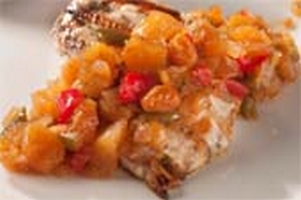At the Kendall College School of Culinary Arts in Chicago, one of the biggest trends we discuss about healthy eating among Americans is a desire for “better for you” dishes. Foods can be mouth-watering and satisfying, yet with lower saturated fat, calories or sodium or more dietary fiber or all of these.
Burgers, ever present on backyard barbecues, do not have to be beef. Turkey, veggie, shrimp and salmon taste amazing grilled with far less fat. For an easy solution, try Chef Big Shake. His shrimp burgers include peppers and spices and are available at many grocery stores.
Kendall’s resident nutrition expert and dean, Chef Renee Zonka, RD, CEC, CHE, says barbecuing is an excellent opportunity to serve more fruits, vegetables, whole grains, leaner meats and antioxidant-rich seafoods because virtually everything tastes better when cooked outdoors.
1. Visit your local farmer’s market. One of the biggest trends in outdoor entertaining today is “farm to fork.” Vegetables grown nearby are at their peak of flavor and nutrition because they’re seasonal and have little time to lose freshness thanks to traveling only a few miles instead of hundreds or even thousands to grace your picnic table. We order from futurefoodsfarms.com for local organic goods and home delivery.
2. Trim the fat, and skin the bird. For burgers, try ground sirloin, which contains less saturated fat than 80/20 (20% fat) ground beef. Choose leaner steaks like top sirloin for grilling, and for fattier steaks such as Porterhouse, trim all visible fat. Do the same for whole-loin pork chops. (Pork tenderloin is naturally leaner.) And skin chicken and duck breasts, thighs and legs before marinating and tossing on the grill to lock that just-grilled flavor into the meat.
3. Go fish. Any seafood simply tastes better grilled! Oily finfish like cod and salmon fillets are high in healthy omega-3 fatty acids. Tilapia is not only a sustainable species, but naturally lean, and can accept virtually any flavor from a marinade or rub before grilling. Heartier fish fillets can go right onto an oiled grill, and more delicate fish can rest on aluminum foil or even sturdy lettuce or banana leaves. With any lean fish, watch grilling times, as less-fatty species cook quickly.And shellfish such as oysters and scallops can grill right in their shells.
4. Grill your veggies. From asparagus to zucchini, grilling coaxes out vegetables’ natural sugars. Marinate for an hour in the refrigerator first or brush fresh veggies (including sliced onion, husked corn on the cob, eggplant slices, sliced bell pepper, sliced yellow squash and mushroom caps and even sturdy long-leaf lettuces like romaine and endive) with olive oil on both sides. Experiment with grill times, turning once for those beautiful caramelized grill marks, until done.
5. Grill fruits, too. Stone fruits like apricots, peaches, plums and nectarines, halved and pitted, and seeded tree fruits
6. Marinate! Marinating meats and vegetables in wine, citrus juice, vinaigrette or a simple brine of salted water for a few minutes to a few hours in the refrigerator before throwing on the grill can both tenderize and add bolder flavor. This means you can use less salt while grilling. Adding a little sweetness to your marinade like fruit juice, brown sugar, molasses or honey helps balance the flavor of a marinade (and adds calories, so be sparing.) Or consider a homemade spice rub from dry herbs and seasonings already in your pantry for a delicious and salt-free flavor boost. For cut fruits, soak in water with a splash of lemon juice (and, if desired, a little cinnamon, nutmeg, allspice, clove or ginger) for up to a half-hour before grilling to maintain their natural juiciness and color.
7. Whole grains are hot (served cold). Instead of high-fat potato and macaroni salads, a lightly dressed quinoa
8. Watch your buns. Replace hamburger and hot-dog buns made with refined white flour with whole-grain varieties for enhanced flavor and good-for-you fiber. But be sure to read labels; “whole wheat” is not the same thing and not as beneficial as “whole grain.”
9. Bake beans without the bacon. A hearty and satisfying side dish of baked beans need not rely on animal fat to taste delicious. Plus, beans are a naturally good source of meatless protein and dietary fiber. Try Chef Zonka’s easy-to-make Stovetop Vegetarian Baked Beans.
10. It’s ALL in the sauce. Most commercial brands of barbecue sauce are loaded with sugar (often in the form of high-fructose corn syrup) and sodium. But these days, more mouthwatering sauces made with less of the bad-for-you stuff are appearing on grocery shelves. Be sure to read labels or consider making your own sauce. Traditional recipes call for ketchup or a canned tomato product plus sugar, spices, vinegar and, sometimes, molasses, Worcestershire sauce, fruit juice and/or mustard. Taste as you go, because making your own sauce gives you complete control over the ingredients in it, as well as the quantity of each. For portion control, don’t pour liberally over meats. Brush.
